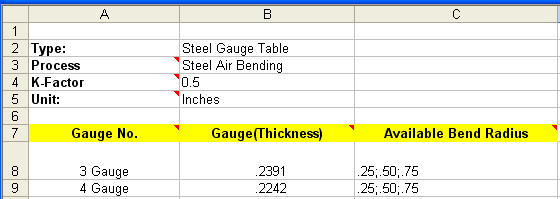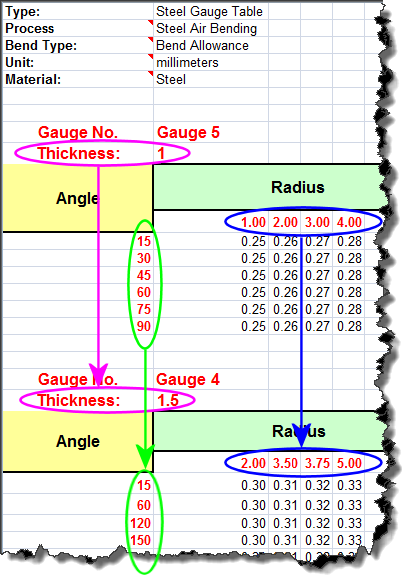Sheet metal gauge tables store properties for a designated material. You can access the sheet metal gauge table from the PropertyManager while creating the base flange.
Use a sheet metal gauge table to assign:
- Gauge thickness
- Allowable bend radii
- K-factor
There are two types of gauge tables:
- Simple. Simple gauge tables have K-Factor, gauge values, gauge thicknesses, and available radii.

- Gauge table/bend table combination. You use a gauge table and bend table in one table. This table combines the bend allowance and bend deduction table so you can specify gauge values.
After creating the base flange, access the sheet metal gauge table by right-clicking
Sheet-Metal 
in the FeatureManager design tree and selecting
Edit Feature.
Use a sheet metal gauge/bend table to specify both thickness and bend values with a single table.
Overriding Default Gauge Table Values
You can use the sheet metal gauge table to assign values for the whole part. This is called the default. However, you can modify K-Factor, bend allowance, and bend deduction per feature or per bend. You can do this in the PropertyManager by selecting Custom Bend Allowance and making selections.
You can use a sheet metal gauge table to assign values for the entire part. This is called the default. However, you can apply bend radius values that are different from the default value in the sheet metal gauge table for features that use specific values (except for the base flange).
- If you select Use Default radius, you can use one general bend radius value from the sheet metal gauge table for all the downstream features.
- If you select Use gauge table, the bend radius value you use is different than the default value from the sheet metal gauge table.
- If you clear both Use Default Radius and Use gauge table, you can type in the bend radius value.
Creating a Sheet Metal Gauge Table
Tables are included in the SOLIDWORKS application, and are located in: install_dir\lang\language\Sheet Metal Gauge Tables.
If you create a sheet metal gauge table, use a semi colon - ; - as a delimiter between values.

With gauge tables, the radii and angles can differ. However, you must list the thickness and radii values in ascending order.
